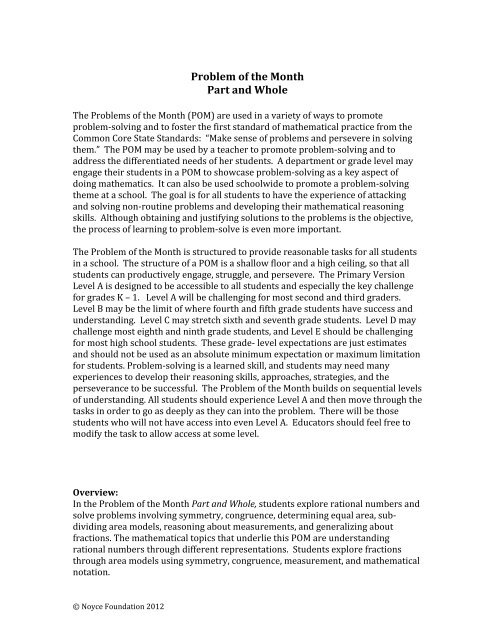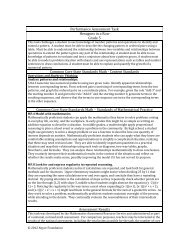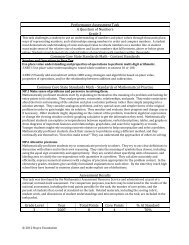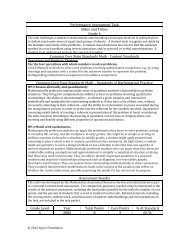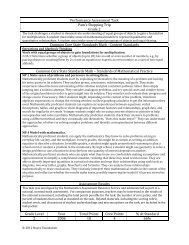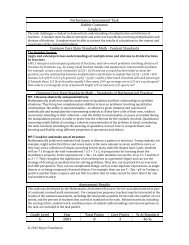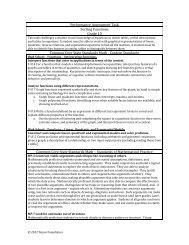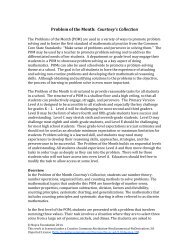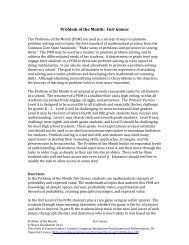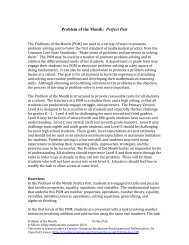subdividing
Problem of the Month Part and Whole - Inside Mathematics
Problem of the Month Part and Whole - Inside Mathematics
- No tags were found...
Create successful ePaper yourself
Turn your PDF publications into a flip-book with our unique Google optimized e-Paper software.
Problem of the Month<br />
Part and Whole<br />
The Problems of the Month (POM) are used in a variety of ways to promote<br />
problem‐solving and to foster the first standard of mathematical practice from the<br />
Common Core State Standards: “Make sense of problems and persevere in solving<br />
them.” The POM may be used by a teacher to promote problem‐solving and to<br />
address the differentiated needs of her students. A department or grade level may<br />
engage their students in a POM to showcase problem‐solving as a key aspect of<br />
doing mathematics. It can also be used schoolwide to promote a problem‐solving<br />
theme at a school. The goal is for all students to have the experience of attacking<br />
and solving non‐routine problems and developing their mathematical reasoning<br />
skills. Although obtaining and justifying solutions to the problems is the objective,<br />
the process of learning to problem‐solve is even more important.<br />
The Problem of the Month is structured to provide reasonable tasks for all students<br />
in a school. The structure of a POM is a shallow floor and a high ceiling, so that all<br />
students can productively engage, struggle, and persevere. The Primary Version<br />
Level A is designed to be accessible to all students and especially the key challenge<br />
for grades K – 1. Level A will be challenging for most second and third graders.<br />
Level B may be the limit of where fourth and fifth grade students have success and<br />
understanding. Level C may stretch sixth and seventh grade students. Level D may<br />
challenge most eighth and ninth grade students, and Level E should be challenging<br />
for most high school students. These grade‐ level expectations are just estimates<br />
and should not be used as an absolute minimum expectation or maximum limitation<br />
for students. Problem‐solving is a learned skill, and students may need many<br />
experiences to develop their reasoning skills, approaches, strategies, and the<br />
perseverance to be successful. The Problem of the Month builds on sequential levels<br />
of understanding. All students should experience Level A and then move through the<br />
tasks in order to go as deeply as they can into the problem. There will be those<br />
students who will not have access into even Level A. Educators should feel free to<br />
modify the task to allow access at some level.<br />
Overview:<br />
In the Problem of the Month Part and Whole, students explore rational numbers and<br />
solve problems involving symmetry, congruence, determining equal area, <strong>subdividing</strong><br />
area models, reasoning about measurements, and generalizing about<br />
fractions. The mathematical topics that underlie this POM are understanding<br />
rational numbers through different representations. Students explore fractions<br />
through area models using symmetry, congruence, measurement, and mathematical<br />
notation.<br />
© Noyce Foundation 2012
In the first level of the POM, students view different geometric figures and<br />
determine whether they can divide the figure into two identical pieces. Their task is<br />
to use symmetry to answer question of same shape and equal area parts. In level B,<br />
students are given a picture of flat geometric shapes made out of clay. Then<br />
students are asked to find a way to make a straight line cut in order to divide the<br />
figure into two parts of equal amounts of clay. In level C, the students are presented<br />
with a rectangular map. The map is divided into six different regions of various<br />
sizes. The task for the students is to determine the fractional part of each region in<br />
terms of the whole rectangular area. In level D, students analyze a triangular region<br />
to once again find the fractional parts of the whole. The students are then asked to<br />
design their own map with sub‐divided regions. In the final level of the POM,<br />
students are presented with an investigation to find five different unit fractions with<br />
a sum of 1. Students must determine whether there is more than one set of five unit<br />
fractions that sum to 1, and if so they must determine a general method for finding<br />
other sets. If not, they prove why not. They also explore other size sets of unit<br />
fractions that can be found to sum to 1.<br />
© Noyce Foundation 2012
Problem of the Month<br />
Part and Whole<br />
Level A:<br />
You and your friend have made a batch of cookies that have<br />
different shapes. You want to share each cookie between you and<br />
your friend so that you can taste each one. You decided you want to<br />
make sure to share the cookie so both pieces are the same. How<br />
should you cut your cookies to make sure each of you have the<br />
same shape and size of the cookies?<br />
Draw a line through the cookies where you would make a cut and<br />
explain why the two pieces are the same.<br />
Problem of the Month Part and Whole P 1<br />
(c) Noyce Foundation 2006. To reproduce this document, permission must be granted by the Noyce<br />
Foundation: info@noycefdn.org.
Level B:<br />
Maggie and Lexie were making funny shapes out of flat clay. They<br />
decided to play a game. Maggie would make a clay shape and Lexie<br />
would have to divide the clay shape using one cut-line. The two<br />
pieces would not have to look the same, but they would have to be<br />
the same size (same amount of clay). Below are Maggie’s clay<br />
shapes. Show where Lexie should make a cut-line to make two pieces<br />
so both would be the same amount of clay.<br />
Maggie’s Shapes:<br />
Explain to Lexie why you know your methods are right.<br />
Problem of the Month Part and Whole P 2<br />
(c) Noyce Foundation 2006. To reproduce this document, permission must be granted by the Noyce<br />
Foundation: info@noycefdn.org.
Level C:<br />
Great Uncle Landowner has a parcel of land he owned. In his will,<br />
he left a map of the land that is divided into different regions. He<br />
wrote the names of each of his nephews and nieces on different<br />
regions of the map. He wrote the name in each region to indicate<br />
who will inherit that section of land. The regions range in size.<br />
Your job is to determine the fractional part of each region as it<br />
relates to the whole parcel. Examine the map below and determine<br />
the fraction piece of each region of land. Explain how you<br />
determined that fractional part awarded to each niece and nephew.<br />
Ann<br />
Bob<br />
Cheryl<br />
Fred<br />
Ely<br />
Dia<br />
Problem of the Month Part and Whole P 3<br />
(c) Noyce Foundation 2006. To reproduce this document, permission must be granted by the Noyce<br />
Foundation: info@noycefdn.org.
Level D:<br />
You work for a puzzle company. You need to determine the<br />
fractional size of each piece so that company will know the materials<br />
needed for the different size pieces. They sent you the following<br />
puzzle. Determine the fractional size of each piece and explain your<br />
reasoning.<br />
You have been assigned to create a more complicated puzzle. Create<br />
a design and provide a key to the fractional size of each shape,<br />
explaining how you determined its size.<br />
Problem of the Month Part and Whole P 4<br />
(c) Noyce Foundation 2006. To reproduce this document, permission must be granted by the Noyce<br />
Foundation: info@noycefdn.org.
Level E:<br />
A unit fraction has a numerator of one and a natural<br />
number denominator. Find five different unit fractions<br />
with a sum of 1.<br />
Determine if there are more sets of five unit fractions, if so<br />
determine a general method for finding other sets. If not,<br />
prove why not.<br />
What other n number of unit fractions can be found that<br />
sum to 1. Explain your reasoning and justify your<br />
conclusions.<br />
Problem of the Month Part and Whole P 5<br />
(c) Noyce Foundation 2006. To reproduce this document, permission must be granted by the Noyce<br />
Foundation: info@noycefdn.org.
Problem of the Month<br />
Part and Whole<br />
Primary Version Level A<br />
Materials: The enlarged paper with Cookies all different<br />
shapes, scissors, pencils and rulers.<br />
Discussion on the rug: (Teacher holds up the heart that was<br />
cut from shape.) “We want to share this cookie between two<br />
friends. How can we make one cut so each friend gets the<br />
same size piece?” (Students think about how to share the<br />
cookie. After soliciting some ideas from students (folding,<br />
drawing different lines, measuring, etc.), the teacher asks,<br />
“How will we know for sure?”<br />
In small groups: (Students have enlarged cookie paper, rulers,<br />
pencils, tissue paper and scissors available)<br />
Teacher says, “Here are different shaped cookies. You want<br />
to share each cookie, so you need to cut each one in half so<br />
the pieces are the same. Where should you cut it to make<br />
sure each one of you has the same size cookie? Draw a line to<br />
show where to cut.” (Students draw a line to show where to<br />
make the cut. After the students are done, the teacher asks<br />
how we can show that both friends get the same amount.<br />
The class may actually cut out some of the shapes and cut<br />
them to show whether or not they are cut in half.)<br />
At the end of the investigation: (Students either discuss or<br />
dictate a response to this summary question.) “Explain how you<br />
know that both friends have the same amount after you cut<br />
the cookie?”<br />
Problem of the Month Part and Whole P 6<br />
(c) Noyce Foundation 2006. To reproduce this document, permission must be granted by the Noyce<br />
Foundation: info@noycefdn.org.
Problem of the Month Part and Whole P 7<br />
(c) Noyce Foundation 2006. To reproduce this document, permission must be granted by the Noyce<br />
Foundation: info@noycefdn.org.
Problem of the Month Part and Whole P 8<br />
(c) Noyce Foundation 2006. To reproduce this document, permission must be granted by the Noyce<br />
Foundation: info@noycefdn.org.
Problem of the Month<br />
Part and Whole<br />
Task Description – Level A<br />
This task challenges a student to use symmetry to divide shapes into two identical pieces, equal area<br />
and equal shape.<br />
Common Core State Standards Math - Content Standards<br />
Measurement and Data<br />
Geometric measurement: understand concepts of area and relate area to multiplication and to<br />
addition.<br />
3.MD.5 Recognize area as an attribute of plane figures and understand concepts of area<br />
measurement.<br />
Geometry<br />
Reason with shapes and their attributes.<br />
3.G.2 Partition shapes into parts with equal areas.<br />
Draw and identify lines and angles, and classify shapes by properties of their lines and angles.<br />
4.G.3 Recognize a line of symmetry for two-dimensional figure as a line across the figure such that<br />
the figure can be folded along the line into matching parts. Identify line-symmetric figures and draw<br />
lines of symmetry.<br />
Common Core State Standards Math – Standards of Mathematical Practice<br />
MP.5 Use appropriate tools strategically.<br />
Mathematically proficient students consider the available tools when solving a mathematical<br />
problem. These tools might include pencil and paper, concrete models, a ruler, a protractor, a<br />
calculator, a spreadsheet, a computer algebra system, a statistical package, or dynamic geometry<br />
software. Proficient students are sufficiently familiar with tools appropriate for their grade or course<br />
to make sound decisions about when each of these tools might be helpful, recognizing both the<br />
insight to be gained and their limitations. For example, mathematically proficient high school<br />
students analyze graphs of functions and solutions generated using a graphing calculator. They<br />
detect possible errors by strategically using estimation and other mathematical knowledge. When<br />
making mathematical models, they know that technology can enable them to visualize the results of<br />
varying assumptions, explore consequences, and compare predictions with data. Mathematically<br />
proficient students at various grade levels are able to indentify relevant external mathematical<br />
resources, such as digital content located on a website, and use them to pose or solve problems. They<br />
are able to use technological tools to explore and deepen their understanding of concepts.<br />
MP.7 Look for and make use of structure.<br />
Mathematically proficient students try to look closely to discern a pattern or structure. Young<br />
students, for example, might notice that three and seven more is the same amount as seven and three<br />
more, or they may sort a collection of shapes according to how many sides the shapes have. Later,<br />
students will see 7 x 8 equals the well-remembered 7 x 5 + 7 x 3, in preparation for learning about<br />
the distributive property. In the expression x 2 + 9x + 14, older students can see the 14 as 2 x 7 and<br />
the 9 as 2 + 7. They recognize the significance of an existing line in a geometric figure and can use the<br />
strategy of drawing an auxiliary line for solving problems. They also can step back for an overview<br />
and shift perspective. They can see complicated things, such as some algebraic expressions, as single<br />
objects or being composed of several objects. For example, they can see 5 – 3(x - y) 2 as 5 minus a<br />
positive number times a square and use that to realize that its value cannot be more than 5 for any<br />
real numbers x and y.<br />
© Noyce Foundation 2012
Problem of the Month<br />
Part and Whole<br />
Task Description – Level B<br />
This task challenges a student to reason about <strong>subdividing</strong> shapes into two parts with equal areas,<br />
but not necessarily equal shapes using one line. Students need to develop arguments to show that the<br />
areas are the same without calculating the areas.<br />
Common Core State Standards Math - Content Standards<br />
Measurement and Data<br />
Geometric measurement: understand concepts of area and relate area to multiplication and to<br />
addition.<br />
3.MD.5 Recognize area as an attribute of plane figures and understand concepts of area<br />
measurement.<br />
Geometry<br />
Reason with shapes and their attributes.<br />
3.G.2 Partition shapes into parts with equal areas.<br />
Common Core State Standards Math – Standards of Mathematical Practice<br />
MP.3 Construct viable arguments and critique the reasoning of others.<br />
Mathematically proficient students understand and use stated assumptions, definitions, and<br />
previously established results in constructing arguments. They make conjectures and build a logical<br />
progression of statements to explore the truth of their conjectures. They are able to analyze<br />
situations by breaking them into cases, and can recognize and use counterexamples. They justify<br />
their conclusions, communicate them to others, and respond to the arguments of others. They<br />
reason inductively about data, making plausible arguments that take into account the context from<br />
which the data arose. Mathematically proficient students are also able to compare the effectiveness<br />
of two plausible arguments, distinguish correct logic or reasoning from that which is flawed, and – if<br />
there is a flaw in an argument – explain what it is. Elementary students can construct arguments<br />
using concrete referents such as objects, drawings, diagrams, and actions. Such arguments can make<br />
sense and be correct, even through they are not generalized or made formal until later grades. Later,<br />
students learn to determine domains to which an argument applies. Students at all grades can listen<br />
or read the arguments of others, decide whether they make sense, and ask useful questions to clarify<br />
or improve the arguments.<br />
MP.7 Look for and make use of structure.<br />
Mathematically proficient students try to look closely to discern a pattern or structure. Young<br />
students, for example, might notice that three and seven more is the same amount as seven and three<br />
more, or they may sort a collection of shapes according to how many sides the shapes have. Later,<br />
students will see 7 x 8 equals the well-remembered 7 x 5 + 7 x 3, in preparation for learning about<br />
the distributive property. In the expression x 2 + 9x + 14, older students can see the 14 as 2 x 7 and<br />
the 9 as 2 + 7. They recognize the significance of an existing line in a geometric figure and can use the<br />
strategy of drawing an auxiliary line for solving problems. They also can step back for an overview<br />
and shift perspective. They can see complicated things, such as some algebraic expressions, as single<br />
objects or being composed of several objects. For example, they can see 5 – 3(x - y) 2 as 5 minus a<br />
positive number times a square and use that to realize that its value cannot be more than 5 for any<br />
real numbers x and y.<br />
© Noyce Foundation 2012
Problem of the Month<br />
Part and Whole<br />
Task Description – Level C<br />
This task challenges a student to determine fractional parts of a rectangle divided into 6 differentsize<br />
regions.<br />
Common Core State Standards Math - Content Standards<br />
Measurement and Data<br />
Geometric measurement: understand concepts of area and relate area to multiplication and to<br />
addition.<br />
3.MD.5 Recognize area as an attribute of plane figures and understand concepts of area<br />
measurement.<br />
3.MD.6 Measure areas by counting unit squares.<br />
Geometry<br />
Reason with shapes and their attributes.<br />
3.G.2 Partition shapes into parts with equal areas.<br />
Number and Operations - Fractions<br />
Develop understanding of fractions as numbers.<br />
3.NF.1 Understand a fraction 1/b as the quantity formed by 1 part when a whole is portioned into b<br />
equal parts, understand a fraction a/b as the quantity formed by a parts of size 1/b.<br />
Common Core State Standards Math – Standards of Mathematical Practice<br />
MP.3 Construct viable arguments and critique the reasoning of others.<br />
Mathematically proficient students understand and use stated assumptions, definitions, and<br />
previously established results in constructing arguments. They make conjectures and build a logical<br />
progression of statements to explore the truth of their conjectures. They are able to analyze<br />
situations by breaking them into cases, and can recognize and use counterexamples. They justify<br />
their conclusions, communicate them to others, and respond to the arguments of others. They<br />
reason inductively about data, making plausible arguments that take into account the context from<br />
which the data arose. Mathematically proficient students are also able to compare the effectiveness<br />
of two plausible arguments, distinguish correct logic or reasoning from that which is flawed, and – if<br />
there is a flaw in an argument – explain what it is. Elementary students can construct arguments<br />
using concrete referents such as objects, drawings, diagrams, and actions. Such arguments can make<br />
sense and be correct, even through they are not generalized or made formal until later grades. Later,<br />
students learn to determine domains to which an argument applies. Students at all grades can listen<br />
or read the arguments of others, decide whether they make sense, and ask useful questions to clarify<br />
or improve the arguments.<br />
MP.7 Look for and make use of structure.<br />
Mathematically proficient students try to look closely to discern a pattern or structure. Young<br />
students, for example, might notice that three and seven more is the same amount as seven and three<br />
more, or they may sort a collections of shapes according to how many sides the shapes have. Later,<br />
students will see 7 x 8 equals the well-remembered 7 x 5 + 7 x 3, in preparation for learning about<br />
the distributive property. In the expression x 2 + 9x + 14, older students can see the 14 as 2 x 7 and<br />
the 9 as 2 + 7. They recognize the significance of an existing line in a geometric figure and can use the<br />
strategy of drawing an auxiliary line for solving problems. They also can step back for an overview<br />
and shift perspective. They can see complicated things, such as some algebraic expressions, as single<br />
objects or being composed of several objects. For example, they can see 5 – 3(x - y) 2 as 5 minus a<br />
positive number times a square and use that to realize that its value cannot be more than 5 for any<br />
real numbers x and y.<br />
© Noyce Foundation 2012
Problem of the Month<br />
Part and Whole<br />
Task Description – Level D<br />
This task challenges a student to analyze a triangular region to find the fractional parts of the whole.<br />
The students are then asked to design their own map with sub-divided regions.<br />
Common Core State Standards Math - Content Standards<br />
Measurement and Data<br />
Geometric measurement: understand concepts of area and relate area to multiplication and to<br />
addition.<br />
3.MD.5 Recognize area as an attribute of plane figures and understand concepts of area<br />
measurement.<br />
3.MD.6 Measure areas by counting unit squares.<br />
Geometry<br />
Reason with shapes and their attributes.<br />
3.G.2 Partition shapes into parts with equal areas.<br />
Solve real-world and mathematical problems involving area, surface area, and volume.<br />
6.G.1 Find the area of right triangles, other triangles, special quadrilaterals, and polygons by<br />
composing into rectangles or decomposing into triangles and other shapes, apply techniques in the<br />
context of solve real-world and mathematical problems.<br />
Number and Operations - Fractions<br />
Develop understanding of fractions as numbers.<br />
3.NF.1 Understand a fraction 1/b as the quantity formed by 1 part when a whole is portioned into b<br />
equal parts, understand a fraction a/b as the quantity formed by a parts of size 1/b.<br />
Common Core State Standards Math – Standards of Mathematical Practice<br />
MP.3 Construct viable arguments and critique the reasoning of others.<br />
Mathematically proficient students understand and use stated assumptions, definitions, and<br />
previously established results in constructing arguments. They make conjectures and build a logical<br />
progression of statements to explore the truth of their conjectures. They are able to analyze<br />
situations by breaking them into cases, and can recognize and use counterexamples. They justify<br />
their conclusions, communicate them to others, and respond to the arguments of others. They<br />
reason inductively about data, making plausible arguments that take into account the context from<br />
which the data arose. Mathematically proficient students are also able to compare the effectiveness<br />
of two plausible arguments, distinguish correct logic or reasoning from that which is flawed, and – if<br />
there is a flaw in an argument – explain what it is. Elementary students can construct arguments<br />
using concrete referents such as objects, drawings, diagrams, and actions. Such arguments can make<br />
sense and be correct, even through they are not generalized or made formal until later grades. Later,<br />
students learn to determine domains to which an argument applies. Students at all grades can listen<br />
or read the arguments of others, decide whether they make sense, and ask useful questions to clarify<br />
or improve the arguments.<br />
MP.4 Model with mathematics.<br />
Mathematically proficient students can apply the mathematics they know to solve problems arising<br />
in everyday life, society, and the workplace. In early grades this might be as simple as writing an<br />
addition equation to describe a situation. In middle grades, a student might apply proportional<br />
reasoning to plan a school event or analyze a problem in the community. By high school, a student<br />
might use geometry to solve a design problem or use a function to describe how one quantity of<br />
interest depends on another. Mathematically proficient students who can apply what they know are<br />
© Noyce Foundation 2012
comfortable making assumptions and approximations to simplify a complicated situation, realizing<br />
that these may need revision later. They are able to identify important quantities in a practical<br />
situation and map their relationships using such tools as diagrams, two-way tables, graphs,<br />
flowcharts, and formulas. They can analyze those relationships mathematically to draw conclusions.<br />
They routinely interpret their mathematical results in the context of the situation and reflect on<br />
whether the results make sense, possibly improving the model if it has not served its purpose.<br />
MP.7 Look for and make use of structure.<br />
Mathematically proficient students try to look closely to discern a pattern or structure. Young<br />
students, for example, might notice that three and seven more is the same amount as seven and three<br />
more, or they may sort a collection of shapes according to how many sides the shapes have. Later,<br />
students will see 7 x 8 equals the well-remembered 7 x 5 + 7 x 3, in preparation for learning about<br />
the distributive property. In the expression x 2 + 9x + 14, older students can see the 14 as 2 x 7 and<br />
the 9 as 2 + 7. They recognize the significance of an existing line in a geometric figure and can use the<br />
strategy of drawing an auxiliary line for solving problems. They also can step back for an overview<br />
and shift perspective. They can see complicated things, such as some algebraic expressions, as single<br />
objects or being composed of several objects. For example, they can see 5 – 3(x - y) 2 as 5 minus a<br />
positive number times a square and use that to realize that its value cannot be more than 5 for any<br />
real numbers x and y.<br />
© Noyce Foundation 2012
Problem of the Month<br />
Part and Whole<br />
Task Description – Level E<br />
This task challenges a student to investigate to find five different unit fractions with a sum of 1.<br />
Students determine whether there is more than one set of five unit fractions that sum to 1, and if so<br />
they determine a general method for finding other sets. If not, they prove why not. They also explore<br />
other size sets of unit fractions that can be found to sum to 1.<br />
Common Core State Standards Math - Content Standards<br />
Number and Operations - Fractions<br />
Use equivalent fractions as a strategy to add and subtract fractions.<br />
5.NF.1 Add and subtract with unlike denominators by replacing given fractions with equivalent<br />
fractions in such a way as to produce an equivalent sum or difference of fractions with like<br />
denominators.<br />
The Number System<br />
Apply and extend previous understandings of operations with fractions to add, subtract,<br />
multiply, and divide rational numbers.<br />
7.NS.1 Apply and extend previous understandings of addition and subtraction to add and subtract<br />
rational numbers; represent addition and subtraction on a horizontal or vertical number line<br />
diagram.<br />
Common Core State Standards Math – Standards of Mathematical Practice<br />
MP.7 Look for and make use of structure.<br />
Mathematically proficient students try to look closely to discern a pattern or structure. Young<br />
students, for example, might notice that three and seven more is the same amount as seven and three<br />
more, or they may sort a collection of shapes according to how many sides the shapes have. Later,<br />
students will see 7 x 8 equals the well-remembered 7 x 5 + 7 x 3, in preparation for learning about<br />
the distributive property. In the expression x 2 + 9x + 14, older students can see the 14 as 2 x 7 and<br />
the 9 as 2 + 7. They recognize the significance of an existing line in a geometric figure and can use the<br />
strategy of drawing an auxiliary line for solving problems. They also can step back for an overview<br />
and shift perspective. They can see complicated things, such as some algebraic expressions, as single<br />
objects or being composed of several objects. For example, they can see 5 – 3(x - y) 2 as 5 minus a<br />
positive number times a square and use that to realize that its value cannot be more than 5 for any<br />
real numbers x and y.<br />
MP.8 Look for and express regularity in repeated reasoning.<br />
Mathematically proficient students notice if calculations are repeated, and look both for general<br />
methods and for shortcuts. Upper elementary students might notice when dividing 25 by 11 that<br />
they are repeating the same calculations over and over again, and conclude they have a repeating<br />
decimal. By paying attention to the calculation of slope as they repeatedly check whether points are<br />
on the line through (1,2) with slope 3, middle school students might abstract the equation (y -2)/(x-<br />
1) = 3. Noticing the regularity in the way terms cancel when expanding (x-1)(x+1), (x-1)(x 2 + x + 1),<br />
and (x-1)(x 3 + x 2 + x + 1) might lead them to the general formula for the sum of a geometric series. As<br />
they work to solve a problem, mathematically proficient students maintain oversight of the process,<br />
while attending to the details. They continually evaluate the reasonableness of their intermediate<br />
results.<br />
© Noyce Foundation 2012
Problem of the Month<br />
Part and Whole<br />
Task Description – Primary Level<br />
This task challenges a student to use tools such as scissors, rulers, and tracing paper to reason about<br />
symmetry and dividing shapes into equal pieces, same size and same shape.<br />
Common Core State Standards Math - Content Standards<br />
Measurement and Data<br />
Describe and compare measureable attributes.<br />
K.MD.2 Directly compare two objects with a measureable attribute in common, to see which object<br />
has “more of/less of” the attribute, and describe the difference.<br />
Geometric measurement: understand concepts of area and relate area to multiplication and to<br />
addition.<br />
3.MD.5 Recognize area as an attribute of plane figures and understand concepts of area<br />
measurement.<br />
Geometry<br />
Reason with shapes and their attributes.<br />
3.G.2 Partition shapes into parts with equal areas.<br />
Common Core State Standards Math – Standards of Mathematical Practice<br />
MP.3 Construct viable arguments and critique the reasoning of others.<br />
Mathematically proficient students understand and use stated assumptions, definitions, and<br />
previously established results in constructing arguments. They make conjectures and build a logical<br />
progression of statements to explore the truth of their conjectures. They are able to analyze<br />
situations by breaking them into cases, and can recognize and use counterexamples. They justify<br />
their conclusions, communicate them to others, and respond to the arguments of others. They<br />
reason inductively about data, making plausible arguments that take into account the context from<br />
which the data arose. Mathematically proficient students are also able to compare the effectiveness<br />
of two plausible arguments, distinguish correct logic or reasoning from that which is flawed, and – if<br />
there is a flaw in an argument – explain what it is. Elementary students can construct arguments<br />
using concrete referents such as objects, drawings, diagrams, and actions. Such arguments can make<br />
sense and be correct, even though they are not generalized or made formal until later grades. Later,<br />
students learn to determine domains to which an argument applies. Students at all grades can listen<br />
or read the arguments of others, decide whether they make sense, and ask useful questions to clarify<br />
or improve the arguments.<br />
MP.7 Look for and make use of structure.<br />
Mathematically proficient students try to look closely to discern a pattern or structure. Young<br />
students, for example, might notice that three and seven more is the same amount as seven and three<br />
more, or they may sort a collection of shapes according to how many sides the shapes have. Later,<br />
students will see 7 x 8 equals the well-remembered 7 x 5 + 7 x 3, in preparation for learning about<br />
the distributive property. In the expression x 2 + 9x + 14, older students can see the 14 as 2 x 7 and<br />
the 9 as 2 + 7. They recognize the significance of an existing line in a geometric figure and can use the<br />
strategy of drawing an auxiliary line for solving problems. They also can step back for an overview<br />
and shift perspective. They can see complicated things, such as some algebraic expressions, as single<br />
objects or being composed of several objects. For example, they can see 5 – 3(x - y) 2 as 5 minus a<br />
positive number times a square and use that to realize that its value cannot be more than 5 for any<br />
real numbers x and y.<br />
© Noyce Foundation 2012


